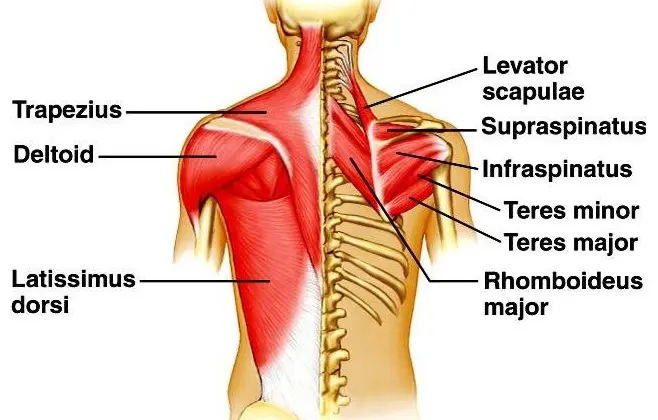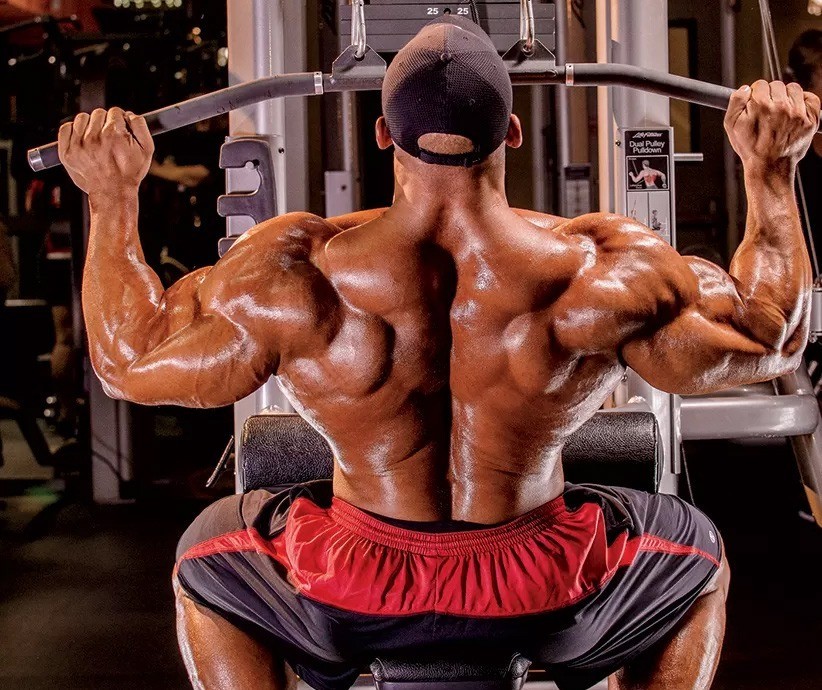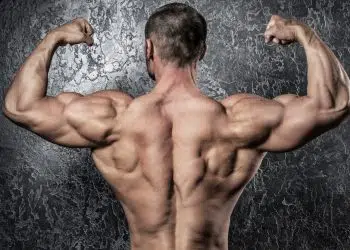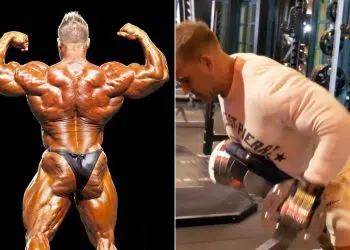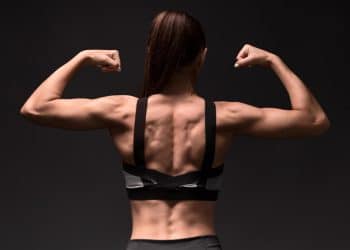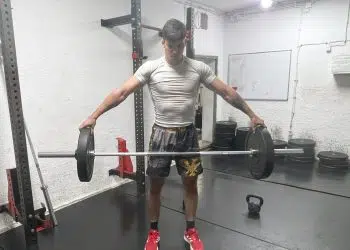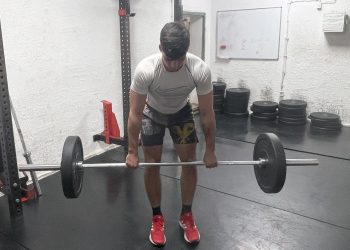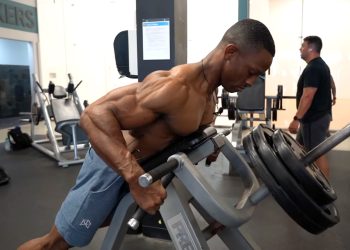How many times a week do you train your chest or arms a week, and how many different exercises do you use? If you have to stop and think about the answer, it’s probably often and a lot!
But what about your back? Do you train it with the same volume?
Sadly, a lot of exercisers are guilty of focusing on their mirror muscles, i.e., those on the front of their body. As far as they’re concerned, what’s out of sight is out of mind. However, this mistake severely compromises aesthetics and function and can even lead to back pain and injury.
I want to redress this imbalance and encourage everyone to pay as much attention to their back muscles as they do those they can see in the mirror. After all, a strong, broad, muscular back is truly a thing of beauty.
In this article, I reveal the best back exercises for building muscle and strength and share some tried-and-tested back-building strategies and tips.
About the Experts
This article is authored by Patrick Dale, Fitness Volt’s Training Editor and former Marine, whose years of personal training expertise are evident in his acclaimed book, “No Gym? No Problem!” Tom Miller, CSCS, a Certified Strength and Conditioning Specialist and content strategist at Fitness Volt, has thoroughly reviewed and validated the information presented in this article.
Level Up Your Fitness: Join our 💪 strong community in Fitness Volt Newsletter. Get daily inspiration, expert-backed workouts, nutrition tips, the latest in strength sports, and the support you need to reach your goals. Subscribe for free!
Recent Updates: On May 24, 2024, Fitness Volt’s Senior Editor Vidur Saini, a certified personal trainer with the American Council on Exercise, refined the list to include the most impactful back exercises. We also added actionable training advice and improved the overall presentation for a more engaging reader experience.
Best Back Exercises for Strength and Muscle Gain
Are you looking for the best exercises to build a stronger, more muscular back? Well, look no further! Here are over 15 fantastic back builders to try.
15 Best Back Exercises
- Pull-up
- Lat Pulldown
- Straight Arm Pulldown
- Barbell Bent-Over Row
- Dumbbell Chest-Supported Row
- One-Arm Dumbbell Row
- Face Pull
- Meadows Row
- Yates Rows
- Pendlay Row
- T-Bar Row
- Seated Cable Row
- Conventional Deadlift
- Romanian Deadlift
- Rack Pull
1. Pull-Up
| Sets & Reps | 3 x 8-12 (or to failure) |
| Equipment Needed | Pull-up bar |
| Target Muscles | Lats, biceps brachii, teres major, rhomboids, trapezius, core |
“Most people use ‘pull-ups’ and ‘chin-ups’ interchangeably,” said Saini. “While pull-ups involve a wide overhand grip which loads the lats, chin-ups use a shoulder-wide underhand grip that transfers the tension to the biceps.”
Both these movements train the lats, but they hit them from different angles. That said, both exercises deserve a place in your back workouts.
Steps:
- Hang from an overhead bar using an overhand, slightly wider than shoulder-width grip. Brace your core and pull your shoulders back and down.
- Flex your elbows to pull your chin up and over the bar.
- Lower yourself down smoothly and repeat.
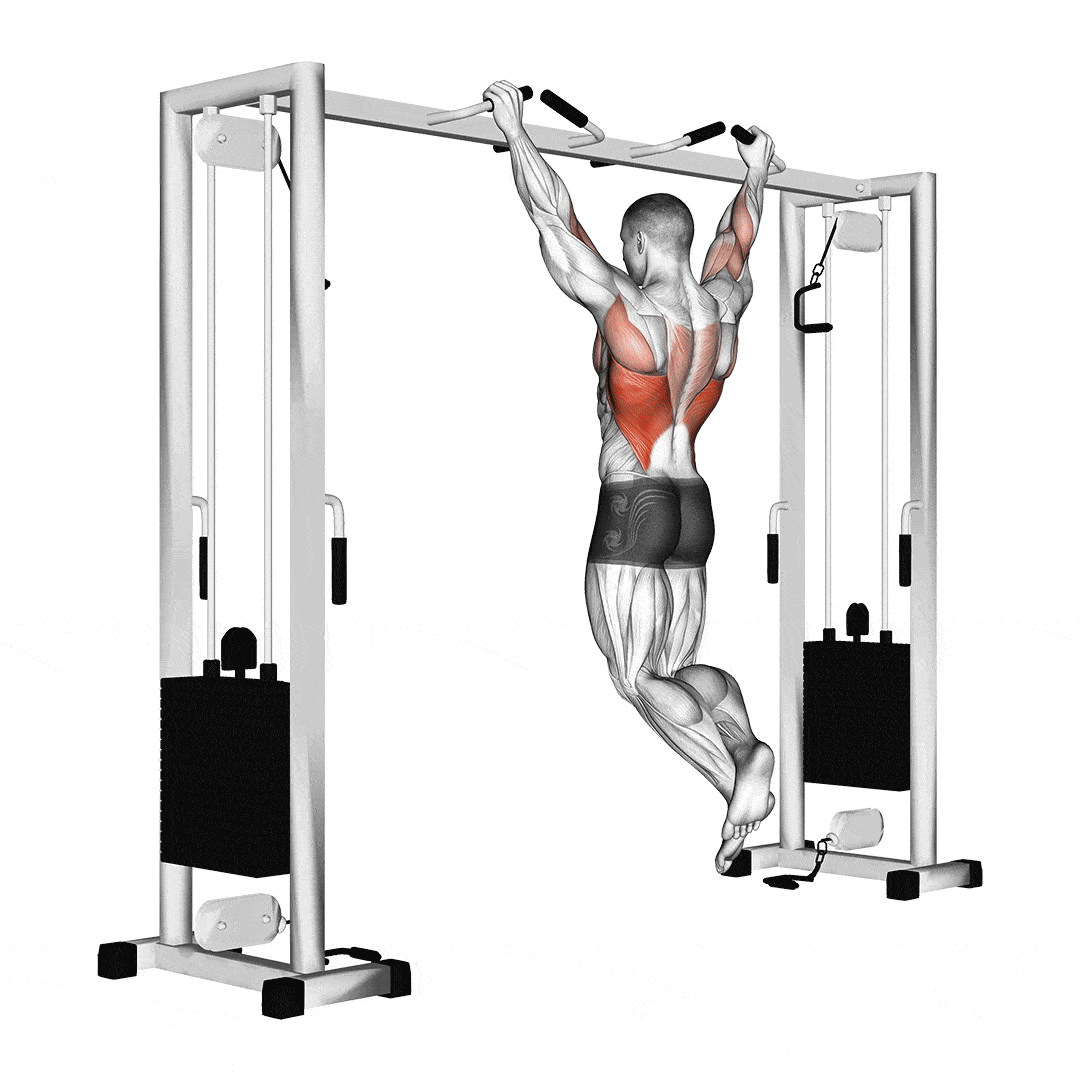
Coach Tips:
- Use a wider grip to increase teres major and upper lat engagement.
- Pause at the bottom and top of each rep to increase muscle engagement.
- Use a dip belt to make this exercise more challenging.
| Difficulty | Progression | Regression |
| Intermediate | Weighted pull-ups, One-arm pull-up negatives | Assisted pull-ups, Negative pull-ups, Scapular pull-ups, Band-assisted pull-ups |
Can’t decide between chin-ups and pull-ups? Check out this guide to their differences and benefits.
2. Lat Pulldown
| Sets & Reps | 3 x 8-12 |
| Equipment Needed | Lat pulldown machine, cable machine with lat pulldown bar |
| Target Muscles | Lats, biceps brachii, teres major, rhomboids, trapezius |
Lat pulldowns are probably the world’s favorite upper back exercise. After all, they’re more accessible (and easier) than pull-ups and chin-ups, and there are several variations you can use to hit various upper back muscles. Whether you are a beginner looking to start training your back or an experienced lifter wanting to add variety to your workouts, lat pulldowns can help.
Slightly lean back (10-15 degrees) during the pulldown to fully engage the lats and control the eccentric (upward) phase for maximum muscle fiber recruitment, cues Saini.
Steps:
- Choose your bar and attach it to your lat pulldown machine. Grab the handle and sit down so your thighs are under the leg restraint. Lean back slightly, lift your chest, and pull your shoulders down and back. Brace your abs.
- Leading with your elbows, bend your arms and pull the handle down to your upper chest. The actual range of motion will depend on the handle being used.
- Smoothly extend your arms and repeat.
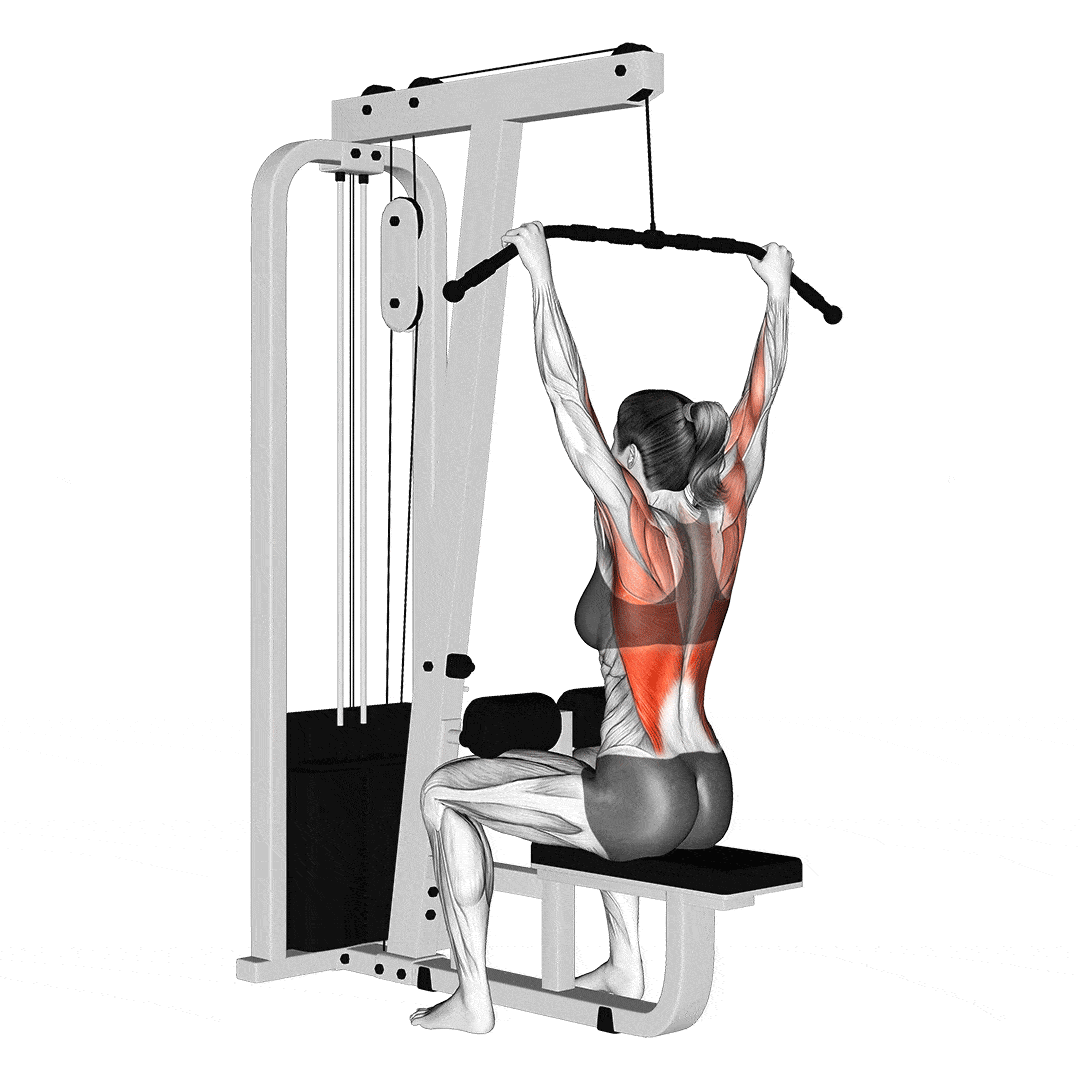
Coach Tips:
- Use wrist straps to reinforce your grip if necessary.
- Vary your workouts by using a wide, medium, narrow, underhand, or neutral grip. In general, the wider the grip, the more upper-lat engagement you’ll experience. In contrast, narrower and underhand grips tend to hit your lower lats a little more.
| Difficulty | Progression | Regression |
| Intermediate | Close-grip lat pulldown | Assisted lat pulldown, Negative lat pulldown, Band-assisted lat pulldown, Machine-assisted pull-ups |
Learn more about how lat pulldown grip widths affect your back in this detailed guide.
3. Straight Arm Pulldown
| Sets & Reps | 3 x 10-15 |
| Equipment Needed | Cable machine with straight bar or rope attachment |
| Target Muscles | Lats, triceps, posterior deltoid |
Most back exercises are compound in nature, meaning they use multiple joints, typically the shoulders and elbows. Straight arm pulldowns are among the few lat isolation exercises where movement occurs at one joint only. Use this exercise to supplement your compound back-building exercises.
Steps:
- Attach a straight bar to an overhead cable machine. Grip the handle with a slightly wider than shoulder-width overhand grip.
- Brace your core and pull your shoulders back and down.
- With straight arms, push the bar down through an arc to touch your upper thighs.
- Raise your arms and repeat.
Coach Tips:
- Maintain a slight elbow flexion throughout the movement. This prevents excessive stress on the elbow joint and ensures continuous tension on the lats.
- Keep your core braced throughout, taking care not to hyperextend your spine.
- Use a thumbless or false grip to maximize lat engagement.
| Difficulty | Progression | Regression |
| Beginner | Increase weight, Slow negatives | Decrease weight |
4. Barbell Bent-Over Row
| Sets & Reps | 3 x 6-10 |
| Equipment Needed | Barbell, weight plates |
| Target Muscles | Lats, rhomboids, trapezius, erector spinae, biceps brachii |
The bent-over barbell row often gets a bad rap for being risky. While the bent-over row does put some stress on your lower back, using a proper form will help mitigate injury risk and increase erector spinae strength. So, don’t dismiss an exercise because it’s hard. Instead, learn to do it correctly and with an appropriate amount of weight!
Saini recommends initiating the pull by retracting the shoulder blades. This enhances scapular stability and optimizes muscle activation.
Steps:
- Hold a barbell with an overhand, slightly wider than shoulder-width grip. Stand with your feet about shoulder-width apart, knees slightly bent. Brace your core.
- Hinging from the hips, lean forward until your upper body is just above parallel to the floor. Let your arms hang down from your shoulders.
- Without rounding your lower back or jerking with your legs, bend your elbows and pull the bar up to your midsection.
- Extend your arms and repeat.
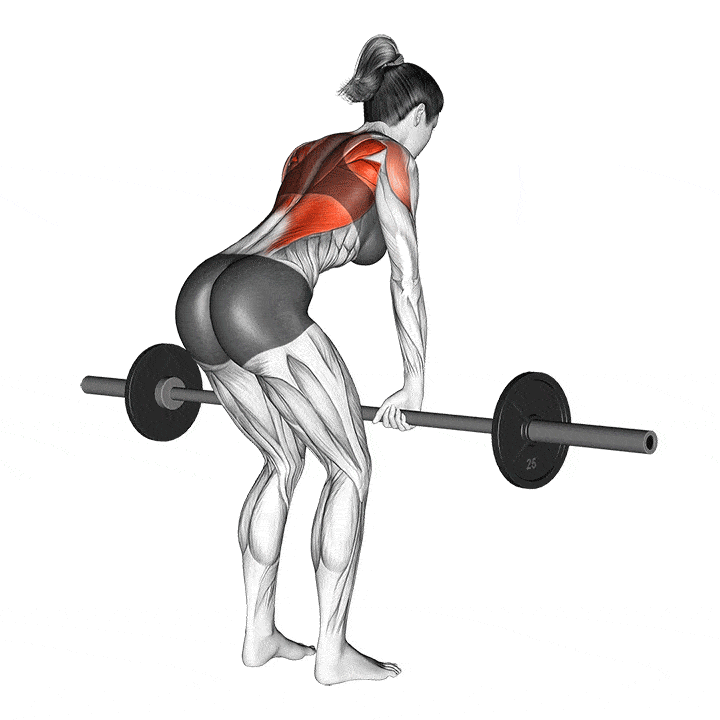
Coach Tips:
- You can also do this exercise with dumbbells instead of a barbell.
- Use a narrower, underhand grip if preferred.
- Hit your upper back more by using a wide grip and pulling the bar into your chest.
| Difficulty | Progression | Regression |
| Intermediate | Pendlay row | Chest-supported dumbbell row, Single-arm dumbbell row |
5. Dumbbell Chest-Supported Row
| Sets & Reps | 3 x 8-12 per arm |
| Equipment Needed | Dumbbell, incline bench |
| Target Muscles | Lats, rhomboids, trapezius, biceps brachii |
Most rowing exercises load the lower back, and there will be times when your spinal erectors are tired. The chest-supported variation takes all the work away from your lower back, leaving you free to focus on pushing your lats to their limit.
Steps:
- Adjust an incline bench to around 30 degrees.
- Lie face down on the bench and hold a dumbbell in each hand. Let your arms hang down from your shoulders. Pull your shoulders down and back.
- Leading with your elbows, bend your arms and pull the weights up and into your lower ribs.
- Extend your arms and repeat.
Coach Tips:
- You can also do this exercise with a barbell if preferred.
- Raise your bench to ensure you can use a full range of motion.
- Do this exercise on a flat bench to hit your back from a different angle. This is called a seal row.
| Difficulty | Progression | Regression |
| Beginner | Increased weight, Seal row | Inverted row |
6. One-Arm Dumbbell Row
| Sets & Reps | 3 x 8-12 per arm |
| Equipment Needed | Dumbbell, bench |
| Target Muscles | Lats, rhomboids, trapezius, biceps brachii |
The single-arm dumbbell row is a classic back exercise. Working one arm at a time means you can identify and fix muscle and strength imbalances and use your free arm to support your lower back. This is a safe and effective move for building a stronger, more muscular back.
“Rotate your torso slightly as you row, allowing your elbow to travel past your body, Saini says. “This increases the range of motion and activates the lats to a greater extent.”
Steps:
- Hold a dumbbell in one hand and stand a couple of feet from a flat, sturdy bench. Brace your core, pull your shoulder back and down, and bend your knees slightly.
- Lean forward and place your free hand on the bench. Make sure your back is flat and not rounded. Let your arm hang down from your shoulder, palm turned inward.
- Leading with your elbow, bend your arm and pull the dumbbell up and into your lower ribs.
- Extend your arm and repeat.
- Do the same number of reps on both sides.
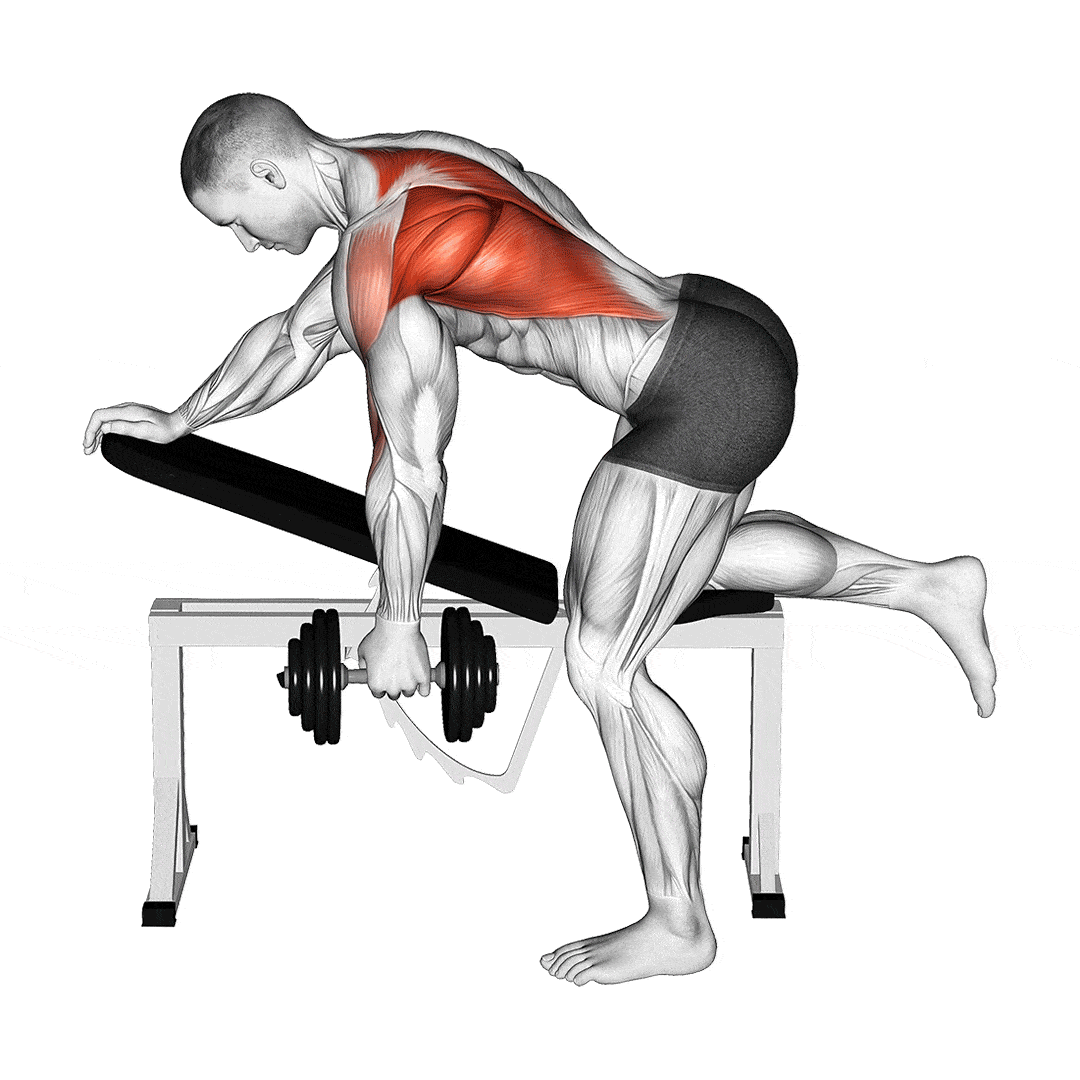
Coach Tips:
- You can also do this exercise with one knee resting on a bench. However, this reduces stability and could lead to twisting your hips or shoulders.
- Drive your elbow back, keeping it close to your ribs, to maximize lat engagement.
- You can also do this exercise with a kettlebell.
| Difficulty | Progression | Regression |
| Intermediate | Increased weight | Chest-supported row, Barbell bent-over row |
7. Face Pull
| Sets & Reps | 3 x 15-20 |
| Equipment Needed | Cable machine with rope attachment |
| Target Muscles | Rear deltoids, rhomboids, middle trapezius |
Face pulls are one of the best exercises for building posterior deltoids and improving your posture. This move should be compulsory for everyone who lifts! Do this exercise to rebalance your shoulders and undo your desk slouch.
Experiment with different grip widths (wide, neutral, close) to target specific muscle fibers in the rear deltoids and upper back, suggests Saini.
Steps:
- Attach a rope handle to a head-high cable machine. Take one end of the handle in each hand and step back into a staggered stance for balance.
- Extend your arms out at shoulder height. Brace your core, and pull your shoulders down and back.
- Leading with your elbows, bend your arms and pull your hands into either side of your head. Imagine you are trying to put your thumbs in your ears. Shrug your shoulders back and together.
- Extend your arms and repeat.
Watch Enrique Santatecla, perform the face pull exercise:
Coach Tips:
- You can also do this exercise with a resistance band attached to a suitable anchor, e.g., a post or pillar.
- Lead with your elbows, and keep your wrists straight throughout.
- You can also do this exercise in a half-kneeling position to stop you from inadvertently using your legs for assistance.
| Difficulty | Progression | Regression |
| Beginner | Increase reps or sets | Band-assisted |
8. Meadows Row
| Sets & Reps | 3 x 6-10 per arm |
| Equipment Needed | Landmine attachment, barbell |
| Target Muscles | Lats, rhomboids, trapezius, biceps brachii |
The Meadows row is named after competitive bodybuilder and influential physique coach John “Mountain Dog” Meadows, who is sadly deceased. Meadows was an exercise science genius, always looking for new ways to make bodybuilding training more effective. This is his take on the one-arm row.
Steps:
- Stand side-on to the end of a T-bar row machine or a landmine bar.
- Adopt a staggered stance so your foot closest to the bar is placed to the rear.
- Hinge forward and hold the end of the bar with an overhand grip. Yes, this is the thick end where the plates are loaded.
- Make sure your lower back is neutral. Brace your abs.
- Raise your hip that’s closest to the bar to put a stretch in your lat. This is the key to effective Meadows rows.
- Bend your arm and lift the weight, driving your elbow out and back to maximize lat engagement. Continue pulling until your elbow is behind your torso.
- Lower the weight down and repeat for the prescribed number of reps.
Coach Tips:
- Wear a weightlifting belt to support and protect your lower back.
- Start and finish each rep with the weight resting on the floor, or avoid touching down between reps. Try both options to see which you prefer.
- Use small diameter plates so you can use the largest possible range of motion.
| Difficulty | Progression | Regression |
| Intermediate | Increased weight | Single-arm dumbbell row |
9. Yates Rows
| Sets & Reps | 3 x 8-12 |
| Equipment Needed | Barbell |
| Target Muscles | Lats, lower traps, rhomboids |
Yates rows are named after legendary bodybuilder Dorian “The Shadow” Yates. Famous for his ultra-intense “blood and guts” training and his massive back, Yates won the Mr. Olympia six times, from 1992 to 1997. This exercise is how Yates preferred to do bent-over barbell rows, which he stated was safer and more effective than the traditional method.
Saini encourages using a wider grip than traditional barbell rows to further emphasize the lower lats and reduce biceps involvement.
Steps:
- Hold a barbell with a shoulder-width underhand grip. Bend your knees slightly, brace your core, and pull your shoulders down and back.
- Hinge forward about 30 degrees, so half as far as conventional bent-over rows.
- Leading with your elbows, bend your arms and pull the bar into your abdomen.
- Extend your arms and repeat.
Coach Tips:
- Use straps to reinforce your grip and a belt to support your back if lifting heavy weights.
- Lead with your elbows and keep your arms close to your sides to make this exercise as effective as possible.
| Difficulty | Progression | Regression |
| Intermediate | Increase weight | Barbell bent-over row |
10. Pendlay Row
| Sets & Reps | 3 x 5-8 |
| Equipment Needed | Barbell |
| Target Muscles | Lats, rhomboids, trapezius, erector spinae, biceps brachii |
Also called dead stop rows due to the weight resting on the floor between each rep, this pause helps protect your back, core, and grip. This allows you to lift heavier, ultimately building greater muscle and strength.
Steps:
- Place a barbell on the floor and stand behind it with your feet about hip to shoulder-width apart, toes under the bar.
- Bend your knees slightly, hinge forward from the hips until your upper body is parallel to the floor.
- Grab the barbell with an overhand, slightly wider than shoulder-width grip.
- Brace your core, pull your shoulders down and back, and pull the bar up into your abdomen.
- Lower the barbell back down to the floor and allow it to settle. Reset your core and repeat.
Watch Enrique Santatecla from Fitness Volt demonstrate the correct Pendlay rows below:
Coach Tips:
- You can also do this exercise with a dumbbell or kettlebell, working one arm at a time.
- Keep your upper arms tucked in close to your sides. Your upper body should remain stationary throughout.
- Do not bounce the bar off the floor. It should come to a dead stop between reps.
| Difficulty | Progression | Regression |
| Advanced | Increased weight | Barbell bent-over row |
11. T-Bar Row
| Sets & Reps | 3 x 8-12 |
| Equipment Needed | T-bar row machine or landmine attachment with T-bar |
| Target Muscles | Lats, rhomboids, trapezius, biceps brachii |
The T-bar row is a classic bodybuilding exercise. Saini advises against leaning back excessively or standing upright. Instead, maintain a slight forward lean to emphasize lat engagement over spinal erector involvement.
Steps:
- Stand astride the T-row bar with your feet about shoulder-width apart. Bend your knees slightly, brace your core, and lean forward to grab the handles.
- Keeping your back slightly arched, bend your elbows and pull the handle to your abdomen or chest.
- Extend your arms and repeat.
Coach Tips:
- Avoid using your legs and lower back to help you lift the weight, as doing so takes tension away from the target muscles and increases your risk of injury.
- Use a wide grip to hit your upper back more and a close grip for your lats.
| Difficulty | Progression | Regression |
| Intermediate | Increased weight | Single-arm dumbbell row |
12. Seated Cable Row
| Sets & Reps | 3 x 8-12 |
| Equipment Needed | Cable machine with seated row attachment |
| Target Muscles | Lats, rhomboids, trapezius, biceps brachii |
If bent-over and T-bar rows are a little too hard on your lower back, there are always seated cable rows. This exercise is significantly more lower back-friendly but works all of the same muscles. For this reason, seated cable rows are a popular gym exercise with beginners and more experienced lifters alike.
Steps:
- Attach your chosen handle to a low pulley machine.
- Sit on the bench with your legs outstretched, knees slightly bent. Grip the handle, sit up straight, brace your core, and pull your shoulders back and down.
- Without using your lower back or legs for help, bend your arms and pull the handle into your midsection.
- Smoothly extend your arms and repeat.
Watch our training coach Enrique Santatecla demonstrate the correct seated cable row below:
Coach Tips:
- You can do this exercise with a wide overhand grip to hit your mid-back or a narrow or underhand grip to work your lats. Alternatively, use a neutral grip if preferred.
- Increase your range of motion slightly by leaning forward from your hips. However, do not round your lower back.
- No cable machine? No problem! You can also do this exercise with a resistance band attached to a suitable low anchor.
| Difficulty | Progression | Regression |
| Beginner | Increased weight | Single-arm cable row |
13. Conventional Deadlift
| Sets & Reps | 3 x 5-8 |
| Equipment Needed | Barbell |
| Target Muscles | Gluteus maximus, hamstrings, erector spinae, quadriceps, core |
If you only have time for one back exercise, the conventional deadlift should be it. No other move works more back muscles, making it the most efficient way to build a stronger, more muscular back. However, the deadlift is also a technically demanding exercise, so make sure your form is good before adding a lot of weight.
Keep your lats tight and pull your chest up before you lift. This creates tension and helps you maintain a neutral spine, cues Saini.
Steps:
- Place a loaded barbell on the floor. Stand behind the bar with your toes underneath. Your feet should be about hip to shoulder-width apart.
- Hinge at the hips and grab the bar with an overhand or mixed shoulder-width grip.
- Straighten your arms, drop your hips, lift your chest, brace your core, and pull your shoulders back and down.
- Drive your feet into the floor and stand up. Take care not to round your lower back or lean back at the top.
- Push your hips back, bend your knees, and lower the weight back to the floor.
- Allow the weight to settle, reset your core and grip, and repeat.
Enrique Santatecla, perform the barbell deadlift correctly in the video below:
Coach Tips:
- Deadlift barefooted for greater stability.
- Use chalk to stop your hands from slipping.
- If you are using a mixed grip, make sure you switch your hands around set-by-set to avoid muscle imbalances.
| Difficulty | Progression | Regression |
| Advanced | Deficit deadlift | Romanian deadlift |
14. Romanian Deadlift
| Sets & Reps | 3 x 8-12 |
| Equipment Needed | Barbell |
| Target Muscles | Hamstrings, glutes, erector spinae, core |
The Romanian deadlift is usually performed during leg workouts. However, it’s also a very effective back builder, hence its inclusion in this list. It’s easier to learn than conventional and more accessible than trap-bar deadlifts. This is a potent exercise that deserves a place in almost every workout, irrespective of what you are training for.
Steps:
- Stand with your feet about hip-width apart, knees slightly bent. Hold a barbell in front of your thighs using an overhand, shoulder-width grip. Brace your core and pull your shoulders back and down.
- Hinging from your hips, lean forward and lower the bar down the front of your legs. Descend until you feel a stretch in your hamstrings.
- Drive your hips forward and stand up, taking care not to lean back at the top of your rep.
- Continue for the prescribed number of reps.
Coach Tips:
- Use straps, chalk, or an alternating grip if lifting heavy weights.
- You can also do this exercise with a trap bar or dumbbells.
- Do one-leg Romanian deadlifts to improve your balance as well as your back strength.
| Difficulty | Progression | Regression |
| Intermediate | Increased weight | Single-leg RDL |
15. Rack Pull
| Sets & Reps | 3 x 3-5 |
| Equipment Needed | Barbell with squat rack or platform |
| Target Muscles | Gluteus maximus, hamstrings, erector spinae, core, traps |
Some lifters find it awkward to deadlift weights from the floor. For tall people and those with short arms or poor flexibility, bending down to reach the floor places their spines in a compromised (rounded) position. Rack pulls involve deadlifting from a higher starting position, making them easier on your lower back. However, they are still an effective back exercise.
“Lower heights emphasize the glutes and hamstrings, while higher heights target the upper back more,” says Saini.
Steps:
- Place your bar on a power rack set to about knee height. Stand behind the bar and grip it with a mixed or overhand shoulder-width grip.
- Straighten your arms, brace your core, and pull your shoulders down and back.
- Drive your feet into the floor, push your hips forward, and stand up. Take care not to round your lower back or lean backward at the top of your rep.
- Return to the starting position and repeat.
Coach Tips:
- Raise or lower the bar according to your flexibility.
- Rest your weights on blocks if you don’t have access to an adjustable power rack.
- Most lifters find they can handle more weight for rack pulls compared with conventional deadlifts.
| Difficulty | Progression | Regression |
| Advanced | Block pulls | Conventional deadlift |
Warming Up for Back Training
A safe and effective back workout starts with a thorough warm-up. Warming up prepares your muscles and joints for what you are about to do, reducing your risk of injury. Given how prone the back is to injury, warming up is non-negotiable, and skipping this critical phase of your workout could have dire consequences.
As well as lowering your injury risk, a good warm-up also ensures that your muscles and nervous system are working properly, making your workout more effective. In short, you’ll be stronger and more fatigue-resistant after warming up, boosting workout performance.
A good warm-up consists of the following components:
Pulse raiser: This part of the warm-up makes you warm! It usually comprises 5-10 minutes of easy cardio. Start slow and pick up the pace over several minutes. Take care not to turn your pulse raiser into a workout. You should feel warm at the end, but not tired. For a back workout, warm up with cardio exercises that work your arms and back, such as a rower, cross-trainer, or air-bike.
Mobility exercises: Mobility exercises warm up and lubricate your joints by increasing synovial fluid production, an oil-like substance your body produces on demand. Joint mobility exercises include shoulder shrugs and rolls, arm circles, and overhead reaches. Focus on the joints you are about to use, not forgetting your spine.
Dynamic flexibility exercises: Static stretches have no place in your warm-up because they put your muscles to sleep and reduce force output potential (strength). Instead, dynamic stretches lengthen and wake up your muscles, making them much more warm-up-appropriate. Good dynamic back stretches include side bends, waist twists, and cat/cows.
Ramped sets: It would be a mistake to jump straight into heavy training immediately after your warm-up. Instead, it’s better to ramp up to your training weights to prepare your muscles for what you are about to do. This is best done by starting light and increasing your weights over several preparatory sets.
For example:
- 10 reps/20kg (empty barbell)
- 8 reps/40kg
- 5 reps/60kg
- 3 reps/80kg
- 10 reps/100kg (first work set).
Read more about warming up for strength training here.
Importance of Strengthening Your Back Muscles
Before we reveal the best exercises for a stronger, more muscular back, let’s first discuss some of the benefits of back training. After all, some of you reading this will need convincing that back training is actually worth the effort!
The benefits of training and strengthening your back include:
A More Balanced Body
Muscles are arranged in pairs across joints. These muscles oppose one another and have opposite functions. Obvious muscle pairings include the biceps and triceps, quadriceps and hamstrings, and anterior and posterior deltoids.
The back muscles, of which there are several, oppose the chest and abdominals, which are two large, powerful muscle groups. So, if you train your pecs and abs, you also need to work your back to ensure both sides of your body are equally developed. After all, you wouldn’t train your biceps and ignore your triceps, would you?
Training your back will enhance your appearance and improve function while lowering your risk of injury.
Improved Posture
Posture is the alignment of your joints, which can be good or bad. When you are in good posture, your joints are “stacked,” and keeping them aligned requires very little effort. There is minimal strain on your muscles and, in the case of the back, no additional pressure on your intervertebral disks and ligaments.
In contrast, when you are in poor posture, your joints are misaligned, so you have to use your muscles more forcefully to stay upright. This is tiring and can cause muscle tension and pain. In addition, there is far more pressure on your spinous ligaments and disks.
Causes of poor posture include:
- Habitual sitting
- Slouching
- Phone and computer use
- Poor flexibility
- Overtraining the muscles on the front of your body
- Undertraining your back muscles
Strengthening your back muscles will give you the strength to hold your body upright against the pull of gravity. Better posture will affect how you look, feel, and perform. It can also help reduce lower back and neck pain.
Read more about slouching and how to fit it here.
Increased Overall Strength
While a big bench press might win you bragging rights at the gym or on social media, back strength is a far better measure of your strength. Not only are things like weighted pull-ups and deadlifts more impressive feats of strength, but a strong back will have a knock-on effect to all your other lifts.
Want to squat more? A stronger back will help! Want to curl more weight? Increase your back strength! Want to bench more? Build a stronger back! A stronger back can even help you run faster, swim further, punch harder, and perform almost any athletic activity better.
In summary, whatever you want to achieve in strength training, a powerful back will help. In contrast, a weak back will always limit your performance.
Level Up Your Fitness: Join our 💪 strong community in Fitness Volt Newsletter. Get daily inspiration, expert-backed workouts, nutrition tips, the latest in strength sports, and the support you need to reach your goals. Subscribe for free!
The V-Taper Aesthetic
A V-taper is where your upper body starts wide and comes in at a narrow waist. This is a very aesthetically pleasing shape and one that most bodybuilders and exercisers greatly appreciate.
While we can’t do much for your waist measurement, we can provide you with the tools you need to widen your upper back. The broader your back, the more impressive your V-taper will be, which can be measured using this calculator.
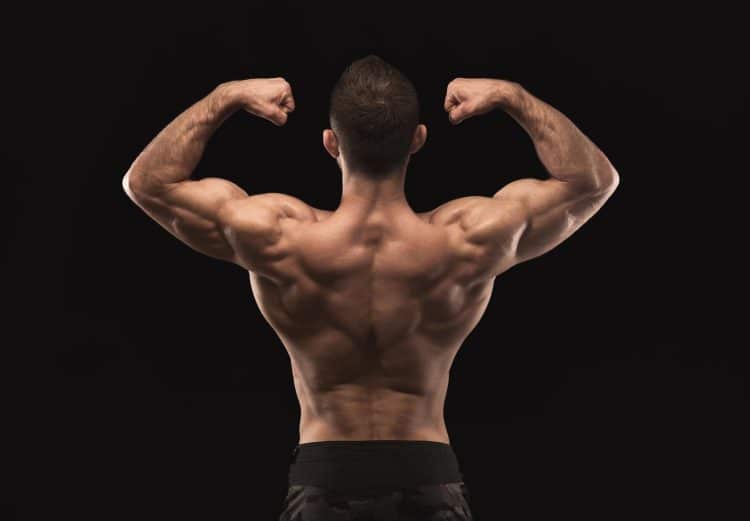
Injury Prevention
As many as 80% of adults will suffer from moderate to severe back pain during their lives (1). Back pain can be debilitating, making many of the tasks of everyday living difficult or impossible. Pain-relieving drugs can help, but given the current opioid crisis, this is probably something that most people should avoid.
A strong back is more robust, resilient, and less injury-prone. For example, you are less likely to strain your back putting out the garbage if deadlifts are part of your workout routine.
So, while there are no guarantees in life, it’s a safe bet that training your back will lower your risk of back injury and some types of back pain.
Understanding Your Back Muscles
“Back” is a very broad term for what is actually a group of large and important muscles. Knowing a little about the anatomy and physiology of your back will help you understand why you need to train this body part from several angles and using a variety of exercises.
The primary muscles of the back are:
Latissimus Dorsi
When it comes to back training, this is the muscle that most people think of and focus on. Located on the sides of your upper back and known as the lats, this muscle is responsible for adduction and extension of the shoulders.
It’s heavily involved in all vertical and horizontal pulling exercises. The lats give your upper back its width, which is why it’s usually the focus of most back-building workouts.
Teres Major
Teres major is a small but mighty muscle that assists the lats in adduction. It’s located just below the armpit and is often called the mini-lat. You’ll have to be pretty lean to see your teres major, but it’s quite prominent when well-developed.
Trapezius
The trapezius, or traps, is a large, diamond-shaped muscle that covers much of your upper back. It comprises three groups of fibers, each with a different function. These fibers are:
- Upper – elevation of the scapula
- Middle – retraction of the scapula
- Lower – depression of the scapula
The traps play a critical role in controlling and stabilizing your shoulder girdle, which is the collective term for the shoulder blades and collar bones. (3)
Rhomboids
The rhomboids are located under the traps and work with the middle fibers of the trapezius to pull your shoulder blades back and together. Like the larger traps, the rhomboids are also critical for stabilizing the shoulder girdle.
Posterior Deltoids
While the deltoids are your shoulder muscles, the posterior or rear head also works alongside your back muscles and shares several of the same functions. As such, most back exercises, especially horizontal pulls such as bent-over rows and face pulls, work your posterior deltoids as much as your lats, traps, etc. (4)
Rotator Cuff
The rotator cuff is a group of deep shoulder muscles that work with your back to control the movements of your upper arms. The rotator cuff muscles are supraspinatus, infraspinatus, teres minor, and subscapularis.
Erector Spinae
The erector spinae is the muscle group that runs up either side of your spine, from your sacrum to the base of your skull. Its main functions are extension, lateral flexion, and stabilization of the spine. (5)
Three Major Muscles of the Erector Spinae:
- Iliocostalis: Located laterally (furthest from the midline)
- Longissimus: Intermediate, located between the Iliocostalis and Spinalis
- Spinalis: Located medially (closest to the midline)
Three Sections for Each Major Muscle:
- Cervicis: The section in the neck (cervical region)
- Thoracis: The section in the mid-back (thoracic region)
- Lumborum: The section in the lower back (lumbar region)
So, for example, you could have the Iliocostalis Lumborum, Iliocostalis Thoracis, and Iliocostalis Cervicis as the three sections of the Iliocostalis muscle.
Multifidus
The multifidus is a near-neighbor of the muscles that make up the erector spinae. Located deep in the spine, this slender but important muscle is involved in the extension and rotation of the spine and is a critical spinal stabilizer.
In summary, your back has many important muscles, which is why it’s such a critical body part. Here’s a handy table compiling the main muscles of the back and their primary functions:
| Muscle Name | Location | Function |
| Latissimus Dorsi | Outside of the upper back |
|
| Teres Major | Under the armpit, upper arm |
|
| Trapezius | Upper back and neck |
|
| Rhomboids | Between the scapula and spine |
|
| Posterior Deltoids | Rear of the shoulder |
|
| Rotator Cuff | Surrounds the shoulder joint |
|
| Erector Spinae | Runs along the spine |
|
| Multifidus | Deep in the spine |
|
Programming Your Back Workouts
Many people choose their back exercises at random. This is a mistake. Your exercises are like the ingredients to a meal, and you’ll get better results if you make appropriate choices. With that in mind, here are some hints and tips for constructing your back workouts.
Learn more about writing bodybuilding programs in this in-depth guide.
Never Skip Your Warm-Up
A good workout always starts with a thorough warm-up – or at least it should. Warming up prepares your muscles, joints, and nervous system for what you’re about to do. Not warming up could make your workout less effective and also increases your chances of injury.
Warming up should take no more than 10-15 minutes, but skipping it could cost you months of lost training due to injury. Long story short, make sure you include a warm-up in any program you write. This is non-negotiable!
Consider your Experience and Goals
Some back exercises are more technically demanding than others. As such, you should pick exercises that match your current experience. For example, beginners should mostly stick to machine and straightforward freeweight and body weight exercises, leaving more complex moves to advanced lifters.
Also, make sure your exercises match your training goals. So, if you don’t want to build muscle power, you don’t need to include high-pulls and swings in your workouts. Also, if you want to build strength, low reps with heavy weights are the way to go. In contrast, light to moderate weights and medium to high reps work best for hypertrophy.
In summary, make sure your workout matches your abilities, needs, and goals. The wrong sort of program can be as useless as no program at all.
Focus on Form
Exercise form or technique is critical, especially for back exercises. After all, many of the 30 movements in our list involve your lower back, and poor form could result in severe injury. Remember, you can’t train if you are injured, so it is critical to make your workouts as safe as possible. Ways to do this include:
- Always warming up correctly
- Using appropriate weights
- Not rushing your reps
- Training with a spotter
- Avoiding rounding your lower back
- Respecting your body’s need for rest and recovery
Bodybuilding injuries are largely avoidable. However, it’s up to you to minimize your risks.
Training Volume and Frequency
Muscles generally respond best to about 12-20 weekly training sets. Fewer sets may produce suboptimal results, and doing more may be a waste of your valuable time and energy. As such, 12-20 sets seem to be the sweet spot for most people.
You can do all of these sets in one workout or, preferably, spread them across two sessions. Twice-a-week back training means that neither workout needs to be overly long and, therefore, won’t be too tiring.
Ultimately, the best training frequency depends on how much time you can dedicate to working out, and anywhere from 1-3 back workouts per week will be effective. (2)
Exercise Variety
Your back is a large and complex group of muscles with several functions. As such, you’ll need a variety of exercises to hit each major muscle with a similar amount of volume. A good leg workout should include exercises for the following:
- Vertical pulls, e.g., pull-ups and pulldowns
- Horizontal pulls (1), e.g., seated rows and bent-over rows
- Vertical pulls (2), e.g., face pulls and wide-grip rows to chest
- Shoulder elevations, e.g., shrugs and farmer’s carries
- Back extensions, e.g., prone back extensions and hyperextensions
- Complex exercises, e.g., deadlifts and Romanian deadlifts
While you don’t need to include all these movements in every back workout, you should try and address them all within each training week, paying equal attention to each one.
Progressive Overload
You are only as strong as your last workout. So, if you want to get stronger, you need to gradually make your workouts more demanding. This is called progressive overload, and applies to all types of resistance training, including bodybuilding, powerlifting, Olympic weightlifting, or just working out for fitness and health.
Ways to make your workouts more challenging include:
- Increase the weight
- Do more reps
- Do more sets
- Shorter rests between sets
- Increase training frequency
- Graduate to more demanding exercises
- Switch your grips, e.g., from underhand to overhand to neutral, etc.
Don’t try to change too many programming variables at the same time. Instead, pick one, milk it for all it’s worth, and then choose another. That way, you can ensure your workouts are always progressive and your gains keep on coming.
Exercise Order
The order of the exercises in your workout matters. Ideally, you should arrange your exercises from hardest to easiest and ensure that whatever you do won’t negatively affect your performance of the next movement. For example, doing back extensions before deadlifts would be a bad idea, as a tired lower back will stop you from performing the deadlift correctly and safely.
Similarly, you should avoid doing similar movements back to back, such as bent-over rows, seated rows, and single-arm rows. That’s just too much rowing! Instead, mix up your movement patterns so you hit your muscles from a variety of angles. This will lead to better development and less localized fatigue.
Finally, it’s generally best to leave your lower back training to the end of your workout. In fact, depending on the exercises that came before, you may not need to train your lower back, as it may already be tired from any indirect work it’s had to do.
Sample Workout Program
So, now you have all the information you need to create your very own back training routine. But, to help you on your way, here is an example program that adheres to these guidelines:
| Workout One | Workout Two | ||
| Exercise | Sets x Reps | Exercise | Sets x Reps |
| Deadlifts | 4 x 6-8 | Romanian deadlifts | 4 x 6-8 |
| Pull-ups | 3 x 8-10 | Chin-ups | 3 x 8-10 |
| Single-arm row | 3 x 10-12 | Seated cable row | 3 x 10-12 |
| Face pulls | 3 x 12-15 | Straight arm pulldown | 3 x 12-15 |
| Bird-dogs | 3 x 12-15 | Back extensions | 3 x 12-15 |
Needless to say, these workouts are for illustrative purposes only, and you should adapt them to match your needs and goals.
FAQs
1. What are the most important back training exercises?
Of all the exercises listed in this article, the cornerstones are deadlifts, pull-ups, and rows. These movements engage multiple muscle groups in the back, providing the most bang for your buck in terms of muscle activation and growth. Build your back workouts around these three exercises and their variations, and you’ll never go far wrong.
2. How often should I train my back?
Training frequency depends on your experience level and goals. Beginners may find once a week sufficient, while intermediate to advanced lifters often benefit from two sessions per week. A balanced approach to training might involve one strength-focused workout and another for hypertrophy.
3. Can I combine back and chest workouts?
Yes, you can train your back and chest in the same session. In fact, adopting a pull (back) and push (chest) order to your exercises is often better than doing several exercises for the same muscle group in a row.
However, the volume and energy required for such a comprehensive workout may be high, which is why some people separate these muscle groups. Try both approaches and see which one you prefer.
4. What’s the role of rep ranges in back training?
Low rep ranges (1-5) with heavy weights are generally used for strength building. However, and contrary to what many people think, you can build muscle using almost any rep range, provided you train close to failure. This means that the effective rep range for building muscle is anywhere from 6 to 30+ reps per set. However, 6-15 is arguably the most practical approach for more time-efficient workouts.
5. Is bodyweight training effective for building and strengthening the back?
Absolutely! Exercises like pull-ups, chin-ups, inverted rows, and back extensions are highly effective. The key is to focus on progressive overload, even when using bodyweight exercises. This invariably means doing more reps per set as you get stronger.
Ultimately, your body cannot really differentiate between lat pulldowns, pull-ups, seated rows, and inverted rows, so don’t feel short-changed if you only have access to bodyweight exercises for your workout.
6. Can I still train my back if I have lower back pain?
While some back exercises may make lower back pain worse, alternatives like chest-supported rows and lat pulldowns are generally safer and easier on the lower back. That said, if you have persistent or severe back pain, consult a healthcare provider before continuing with your training, as there is a risk that you could make things worse.
7. How can I avoid plateaus in my back training?
Plateaus typically happen when you do the same workout for too long. Simply put, your body gets bored of your training routine and has no reason to continue growing or getting stronger. It’s a sort of impasse or status quo.
To avoid such plateaus, focus on progressive overload by increasing weights, reps, or sets whenever practical. Also, periodically change your exercise selection and workouts to maintain your progress.
However, you should avoid the temptation to “program hop” and change your routine too often. This can be as detrimental to your progress as never changing your workouts.
Feel free to pose your own questions in the comment section below, and we’ll get back to you ASAP.
Best back Exercises – Wrapping Up
Your back might be out of sight, but it should never be out of mind. While you can’t see your back, everyone else can, and a well-developed, broad, thick back is as impressive to look at as it is functional.
That doesn’t mean you need to stop training your chest, biceps, quads, or abs. Instead, it just means you should treat your back with the care and attention you spend on the rest of your muscle groups.
Include vertical and horizontal pulls in your well-rounded back training plan, and don’t forget your lower back, too. Using a variety of exercises will ensure your build thickness and width from the top of your back to the bottom.
Finally, there is no need to get married to your back workout; even the best program is not for life! Change your routine every couple of months to avoid plateaus and boredom.
Finally, focus on progressive overload and getting stronger. That’s the secret to building the back of your dreams.
More Back Training Insights
Though this guide provides comprehensive advice on training the back from top to bottom, it’s merely an introduction. A treasure trove of knowledge on back training awaits your discovery. Dive into your next read:
- Best Lower Back Exercises With Dumbbells
- 15 Best Compound Back Exercises + Workouts
- The Best 30-Minute Back Workout for Size and Strength
- The 8 Best Lower Back Exercises + Workout
- The 15 Best Cable Back Exercises & Workouts to Level Up Your Training
- 13 Best Bodyweight Back Exercises For A Yoked Posterior Chain
- Best Old-School Back Workouts
- Best Back Exercises to Build Strength and Muscle for CrossFit
- Best Back Workouts to Protect you Against Injury and Build Strength
References:
- Freburger JK, Holmes GM, Agans RP, Jackman AM, Darter JD, Wallace AS, Castel LD, Kalsbeek WD, Carey TS. The rising prevalence of chronic low back pain. Arch Intern Med. 2009 Feb 9;169(3):251-8. doi: 10.1001/archinternmed.2008.543. PMID: 19204216; PMCID: PMC4339077.
- Barra-López, M. E., López-de-Celis, C., Pérez-Bellmunt, A., Puyalto-de-Pablo, P., Sánchez-Fernández, J. J., & Lucha-López, M. O. (2020). The supporting role of the teres major muscle, an additional component in glenohumeral stability? An anatomical and radiological study. Medical hypotheses, 141, 109728.
- Ourieff J, Scheckel B, Agarwal A. Anatomy, Back, Trapezius. [Updated 2020 Aug 22]. In: StatPearls [Internet]. Treasure Island (FL): StatPearls Publishing; 2021.
- Elzanie A, Varacallo M. Anatomy, Shoulder and Upper Limb, Deltoid Muscle. [Updated 2020 Aug 22]. In: StatPearls [Internet]. Treasure Island (FL): StatPearls Publishing; 2021.
- Modes RJ, Lafci Fahrioglu S. Anatomy, Back. [Updated 2021 Mar 27]. Treasure Island (FL): StatPearls Publishing; 2021.

